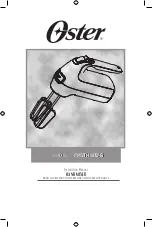
50
MIDI IMPLEMENTATION
Using the MIDI Ports
There are three types of MIDI messages
that can be used to control
ULTRA MUTE
:
MIDI Note Messages, Program Change Mes-
sages, and MIDI System Exclusive (Sysex)
Messages. The standard MIDI implementation
table is located in
APPENDIX A
.
Note:
The letter “h”
following a number
indicates that the number
is in hexadecimal format.
The
ULTRA MUTE
firm-
ware is fixed at MIDI channel 16 and cannot
be changed by the end user.
MIDI Note Messages
MIDI Note Messages are used to change the
state of a single mute node.
The mute nodes in the SR40•8 are turned
on and off using the Note On command and re-
spond to data on MIDI channel 16 (Status
Byte = 10011111 = 9Fh).
The structure of the message is as follows:
System Exclusive Messages (Sysex)
Sysex messages can be used to transmit
data between a MIDI device and
ULTRA
MUTE
. You can transfer all or part of the data
in
ULTRA MUTE
’s memory to a MIDI controller
or sequencer, or transfer data from the con-
troller into
ULTRA MUTE
, using MIDI Sysex
messages.
Note:
Sysex messages do not change the cur-
rent state of the console, but only transfer data
to and from
ULTRA MUTE
’s memory. When a
Sysex Request is made, two horizontal bars appear
in the Numeric Display while data is being trans-
ferred (usually only noticeable during longer
data transfers). Once the transfer is complete,
use MIDI Note Messages or Program Change
Messages to implement new Groups or Snapshots.
The structure of the message is as follows:
<F0> <00 00 66> <03> <0F> <NN> <F7>
03 = SR40•8
04 = SR56•8
ULTRA MUTE
recognizes certain Message
Numbers to move data between its memory
and the host (computer). See the table on
page 11 for descriptions and examples of the
messages recognized by
ULTRA MUTE
.
NN is the position within the Sysex Message
where the Message Number and data is located
(underlined sections in the table).
Snapshot Sysex requests
and dumps are sent and re-
ceived with Snapshot
number first, followed by the
mute node data. All Snap-
shot mute node data is nibblized low-high.
When several Snapshot Sysex dumps are sent
at a time to the SR40•8/SR56•8,
there must be
a 50 millisecond or greater time interval be-
tween each Snapshot.
Group Sysex requests and dumps are sent
and received with Set numbers first, followed
by the Group number and the mute node data.
All Group Mute node data is nibblized low-
high. When several Group Sysex dumps are
sent at a time to the SR40•8/SR56•8,
there
must be a 50 millisecond or greater time interval
between each Set.
Byte 1
Byte 2
Byte 3
9Fh
0kkkkkkk
0vvvvvvv
9 = Status (Note On)
F = MIDI Channel 16
0kkkkkkk = mute node number (see
Appendix B
)
vvvvvvv = value (0 = mute off, 1-127 = mute on)
Since mute nodes are either ON or OFF, a
Value of 0 is recognized as mute off, and a
value of 1-127 (any non-zero number) is recog-
nized as mute on.
ULTRA MUTE
uses the value
40h (64 decimal) to represent mute on.
Program Change Messages
Program Change Messages are used to
change Snapshots in
ULTRA MUTE
, which re-
sponds to data on MIDI channel 16 (Status
Byte = 11001111 = CFh).
The structure of the message is as follows:
Byte 1
Byte 2
CFh
0ppppppp
C = Status (Program Change)
F = MIDI Channel 16
0ppppppp = Snapshot number (00-99=00-63h)
Note:
ULTRA MUTE
must be in Snapshot mode
to respond to Program Change Messages.
















































